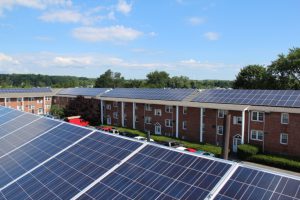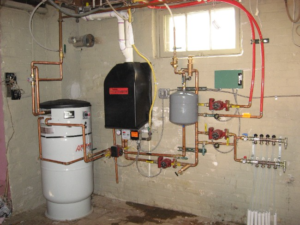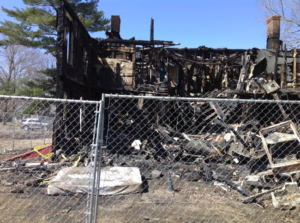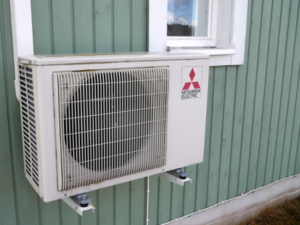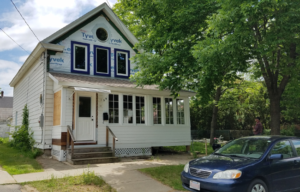Heat Pump vs Furnace Calculator for Natural Gas Replacement
| . Posted in News - 21 Comments
A MassLandlords air source heat pump vs furnace calculator has been developed to help owners, managers, and builders evaluate operational costs of all-electric buildings. The spreadsheet calculator allows members to model an apartment, a natural gas furnace or boiler, and a variety of commercially available air source heat pumps. Then each heat pump can be compared to the natural gas furnace or boiler for annual operating cost. This tool is a feature available to members only and will work to compare heat pumps vs baseboard or ducted heat.
Jump to
- Resources
- Aren't New Gas Furnaces and Boilers Very Efficient?
- Technical FAQ/Spreadsheet Doesn't Work
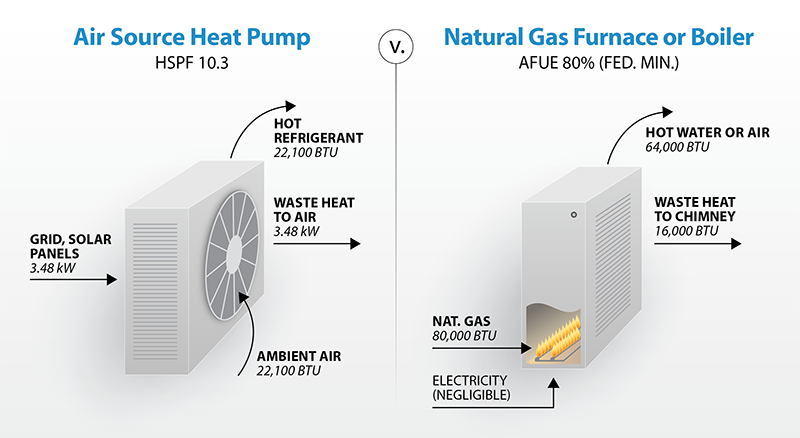
Key differences: You need 3 of these heat pumps to equal 1 of these boilers. The heat pump moves much more heat than you pay for, because the heat comes from air not fuel.
Why Do We Need a Heat Pump vs Furnace Calculator?
This tool is needed because natural gas is near historic low prices, leaving many retrofits and new construction projects continuing to install natural gas as a primary heat source without thinking. Natural gas has been an essential and improving technology for over a century. Why shouldn’t we keep using it? Because natural gas is regrettably a dead-end technology, like so many other technologies before it. There are four main reasons:
First, natural gas is explosive, as we saw tragically in the Merrimack valley gas explosions of 2018. The infrastructure needed to keep it flowing safely is old and aging fast.
Second, natural gas is a potent source of greenhouse gases, not just when it burns, but especially when it leaks. Natural gas is mostly methane, and methane is a more potent greenhouse gas than carbon dioxide. Gas leaks out of pipes at the rate of tens of thousands of metric tons per year in Massachusetts alone, from approximately ten thousand new leaks annually.
Third, even if you don’t care about safety or the climate, natural gas is decreasingly available to businesses: natural gas moratoriums in Western MA have occurred, and in other parts of the state, as well, new hookups have been delayed or denied. (Gas moratoriums have even trapped owners with preexisting service after the previous renter failed to pay their bills.)
And fourth, natural gas is non-renewable. Barring some unforeseen revolution in chemical engineering, we will eventually extract all that remains available to us, driving prices up in the long-term. (The EIA predicts residential gas prices will rise 1% per year for the next 30 years, whereas residential electricity prices will fall.)
These four reasons add up to a fifth concern, which is that Massachusetts seems likely to tax or regulate natural gas so as to increase its price faster than economics would indicate.
All of these factors make it uncertain how much a new natural gas furnace or boiler will cost to operate over the life of the system. One thing is clear: there is no upside. Natural gas will likely never be cheaper or more available than it is at time of writing. Heating systems should be selected for a 10- to 30-year service life, over which the uncertainty that comes with natural gas looms large.
Air source heat pumps, on the other hand, have a very predictable operating cost. The price of electricity rises more or less with inflation. Local solar generation gives you the option of taking supply costs into your own hands and monetizing solar with renters. This makes it possible to know with relative certainty the lifetime operating costs of an air source heat pump. Unlike natural gas furnaces and boilers, which seem unlikely ever to be cheaper, air source heat pumps seem likely never to be more expensive than they are today (after adjusting for inflation).
Note that we are focusing on operating costs, which are only one of thee three primary costs alongside installed cost and maintenance. This tool focuses on operating cost of heat pumps vs natural gas.
This tool is unbiased. It shows that certain air source heat pumps included in the model are three times as expensive to operate, on a per-BTU basis, than a natural gas furnace or boiler. On the other hand, it shows other heat pumps are cheaper than natural gas furnaces or boilers. This tool uses real performance data and actual weather to prove that system selection matters.
We first wrote about how heat pumps are now cheaper than natural gas in April 2018. Since then, we have received objections to that article like the following:
“If a unit has resistance heat, insulation and heat pump installation are great ideas, but the concept of converting from a boiler to heat pumps will never, ever, be economically justified.”
The spreadsheet proves this comment was broadly correct, if one throws a dart at any number of heat pump models. But the comment is specifically wrong when the apartment is insulated, the heat pump is optimized for cold weather, and the system is sized and selected for the space.
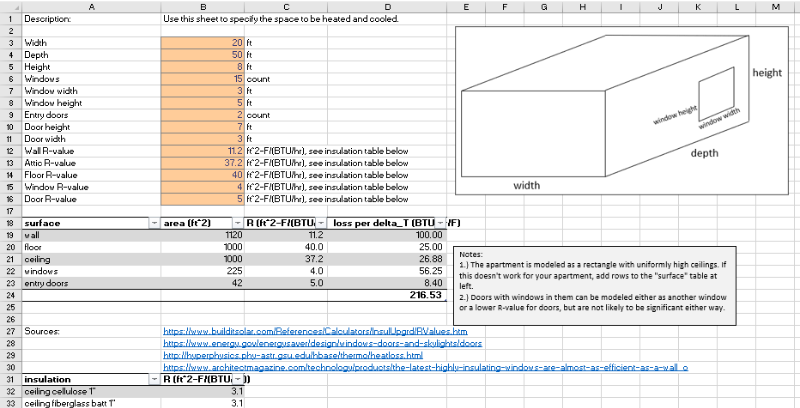
The heat pump vs natural gas spreadsheet tool models an apartment as a simple rectangle with areas and R-values for the various surfaces include windows, doors, etc.
How to Use the Heat Pump vs Furnace Calculator Spreadsheet
The air source heat pump vs natural gas calculator spreadsheet evaluates the relative operating costs of air source heat pumps vs a natural gas boiler or furnace.
The spreadsheet uses built-in Excel formatting:
1.) Enter data in orange cells in the "apartment", "gas" and "air source" worksheets in this workbook.
2.) Look at the "comparison" worksheet. Select the model of heat pump you wish to compare.
The tool uses 2019 daily weather data from the National Weather Service’s station at the Worcester, MA regional airport, near the geographic center of MA.
New models of heat pump can be added to the tool and compared. Instructions are provided in the spreadsheet.
Known Limitations of the Heat Pump vs Natural Gas Calculator Spreadsheet
As with any model of the real world, this spreadsheet tool is not reality. It is only meant to approximate real differences between natural gas boilers, furnaces, and air source heat pumps.
This tool requires familiarity with Microsoft Excel. You can learn excel online.
The 2019 actual weather loaded as a default was recorded at Worcester Regional Airport, near the geometric center of Massachusetts. Massachusetts has several different climate regions. Central plain data is not necessarily adequate to compare Berkshires, North or South Shore, or Cape and Islands. If Worcester isn’t close enough to your climate, you will need to update the "heating degree days" table in the worksheet. You can load data from a different location using DegreeDays.net.
Past weather is no guarantee that future weather will be the same. This tool will approximate a correct answer for regions outside of Massachusetts only when you update the tool with local data.
This tool compares heating only, not cooling. The tool does estimate air source cooling costs, but in New England there is no commonly used natural gas cooling option for comparison.
The comparison produced is only as good as the data you enter. Make sure you have correctly entered data relating to the boiler or heat pump you are considering. The default furnace is 80% AFUE, indicating an old system (retrofit). New construction might install a 90% or better system.
Before making any decision to purchase, consult with a licensed HVAC installer to be sure that the system you want is appropriately sized for your building and climate. An HVAC installer may refuse to retrofit an existing building to heat pumps on the basis that your insulation is inadequate, or for other reasons. This excel model may not accurately reflect your building conditions.
This tool does not compare cost of capital (installation cost).
This tool does not compare maintenance costs.
Maintenance is a significant consideration, especially if the heat pump selected requires its refrigerant lines and fittings be replaced on a shorter interval than the gas system being compared. Many gas systems are “low maintenance” for their entire service life of 30 years. Heat pumps on the other hand may follow a ten-year maintenance cycle, like a water heater. They may be “very low to no maintenance” for approximately ten years, and then depending on the make and model, may require a new condenser, a partial rebuild, and/or new refrigerant fittings and seals.
This tool does not account for historical variations in gas and electricity prices. This tool does not account for the probability that gas or electricity prices may change in the future.
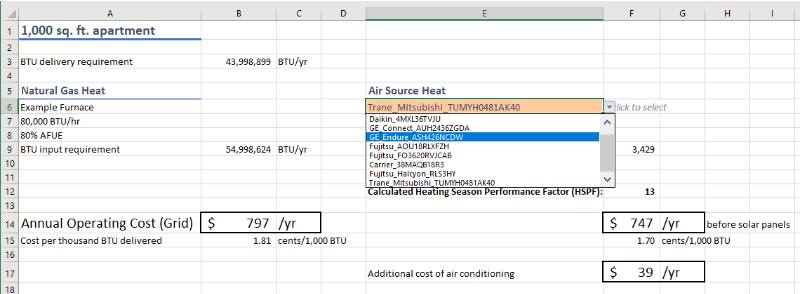
The heat pump vs furnace calculator will work for boilers, furnaces, or any natural gas heat source. Heat pumps are extensively modeled. An easy-pull down lets you evaluate different heat pumps. Excel users, add your own heat pump and compare.
How the Heat Pump vs Furnace Calculator Spreadsheet Works
The heat pump vs furnace spreadsheet calculator is designed to take performance data from the Northeast Energy Efficiency Partnerships (NEEP) “Cold Climate Air Source Heat Pump List.” The NEEP dataset provides a variety of metrics on thousands of model numbers across dozens of brands. Each page in the dataset indicates how much heat a given heat pump can produce at a given ambient temperature, and how much energy this costs. Many heat pumps on the NEEP list are variable speed. The heat pump vs. natural gas calculator spreadsheet assumes all heat pumps are variable speed. The spreadsheet tool also assumes that performance varies linearly from low to high speed.
Let’s consider the performance of an example variable speed heat pump: the Trane Mitsubishi multizone ductless (model TUMYH0481AK40). When the ambient temperature is 17 Fahrenheit, this system moves a minimum 11,628 BTU/hr at a cost of 0.92 kW. It can increase to full speed and move 59,011 BTU/hr at a cost of 5.44 kW.
When the ambient temperature is colder, heating performance generally degrades. The Trane Mitsubishi model above will require 7.92 kW to produce only 54,000 BTU/hr at 5 Fahrenheit. In other words, it will produce 8% less heat for 45% more effort. (If you are carrying out new construction, you should evaluate ground source heat pumps as an alternative to air source. Ground source heat pumps operate on the same principle as air source heat pumps, but benefit from a constant, higher ground temperature of around 50 F.)
For each day in 2019 (or any other year you enter), the air source heat pump vs. natural gas calculator estimates the heat loss from the apartment in terms of BTU/hr. The tool then calculates how many condensers are required to hold the apartment at its interior temperature set point each day. The system is automatically sized for the coldest day in the year, with one or more condensers being modeled as needed. Each day of the year, the sized system will cycle one more condensers between off, minimum and maximum wattage.
Metrics like “Heating Season Performance Factor” (HSPF), Seasonal Energy Efficiency Ratio (SEER), and other metrics are specifically not considered in this tool. These metrics are useful to identify makes and models of interest. But because these metrics are gross estimates of efficiency, the metrics cannot always be relied upon to size a system under real world variability.
The model assumes heat pump performance varies linearly between design points, even though the table is broken into discrete design points of 5 °F, 17 °F and 47 °F. Example: the output and power consumption at 11 °F will be halfway between the performance at 5 °F and 17 °F.
Selected Comparisons
The spreadsheet’s default apartment is a 1,000 square foot rectangular unit located below attic insulation and above another unit heated separately. It is assumed that there are 15 large EnergyStar windows, 2 steel-clad doors, and MassSave-style blown cellulose in the walls. It is assumed there are no leaks.
The spreadsheet’s default natural gas heat is an 80% efficient boiler capable of 80,000 BTU/hr input (64,000 BTU/hr output). The modeled annual heating cost for this boiler is $797 per year.
With no bias other than brand name recognition, we selected half a dozen varieties of heat pumps to evaluate. Some of these are ducted, which would likely not be used in a retrofit situation. Others selected were ductless.
In general, heat pumps that fared impressively badly were underpowered for a cold climate. For instance, consider the Fujitsu AOU18RLXFZH, with a maximum output of less than 25,000 BTU/hr at 47 Fahrenheit. Although cold-rated, meaning it can generate heat in cold climates, it is not optimized for cold climates. This system requires 2 condensers to keep the well insulated apartment at its set point on the coldest day of the year. The modeled annual heating costs for this system are over $2,404 per year. This is three times more expensive than natural gas. In terms of HSPF, it is equivalent to electric resistance heat. This heat pump is really designed to be an air conditioner most of the time.
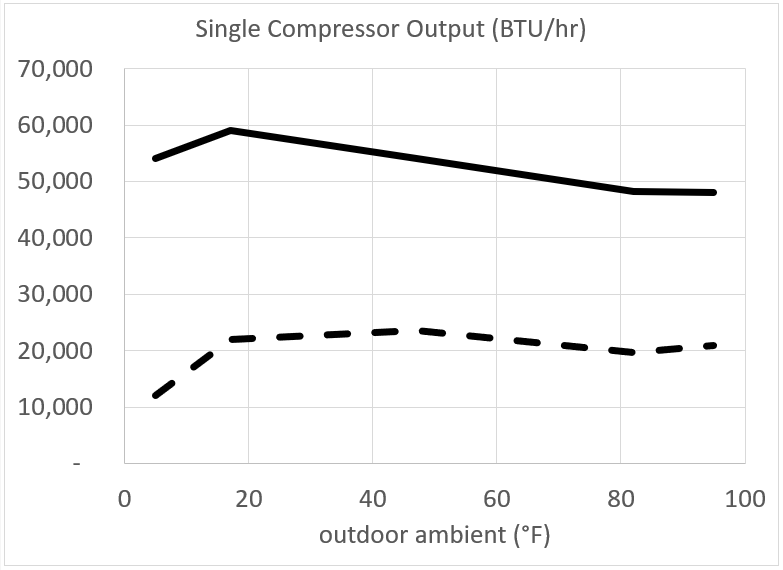
Heat pump performance varies as a function of outdoor ambient temperature, meaning what works best in the Mid-Atlantic won’t be optimal for New England and vice versa. Shown in solid, a Trane Mitsubishi heat pump; dashed, a Fujitsu. The brand is not important. What is important is the overall height of the line (how much heat output, meaning how many condensers) and where the line peaks. The solid model would be a better all around choice for New England, while the dashed model may be a better all around choice for the lower Mid-Atlantic and DC.
On the other hand, consider the multizone ductless Trane Mitsubishi TUMYH0481AK40. The maximum output of this system is 59,011 BTU/hr at 17 Fahrenheit. At this power output, it is as powerful as the natural gas boiler. This system requires one condenser to keep the apartment at its set point. Even on the coldest day of the year, the heat pump does not exceed a run time fraction of one-third, meaning it will be off two-thirds of the time. This is very similar to the cycles experienced by powerful natural gas boilers. The modeled annual heating costs for this system are $628 per year, less than the natural gas boiler by $169 per year.
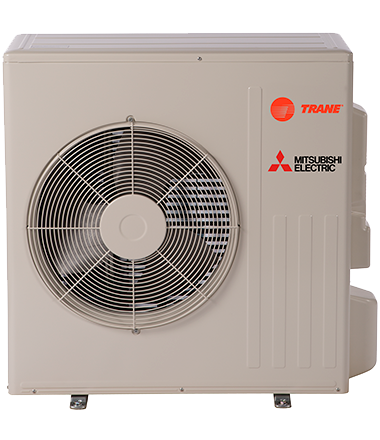
This Trane Mitsubishi model PH has a Heating Season Performance Factor (HSPF) of 13.5, making it both cold rated and efficient at low temperatures. https://www.trane.com/residential/en/products/ductless-systems/mini-split-indoor-unit/ph-series-outdoor-heat-pumps/
The spreadsheet calculator allows us to calculate a break-even maintenance and install cost. For instance, if this heat pump requires less than $169 worth of additional capital every year, in terms of maintenance and depreciation, then it will break even against natural gas.
What if we change the assumption of an 80% efficient boiler and instead model a 95% efficient boiler? Then the natural gas costs drop to $671 per year. This makes natural gas cheaper equivalent to or just slightly more expensive than the Trane Mitsubishi heat pump.
As discussed in the introduction, savings from more efficient gas furnaces and boilers may be offset by future cost increases to natural gas supply.
Depending on your local electricity rate, you may need to lower or increase the rate in the spreadsheet.
Any of these factors can influence the comparison between a given heat pump and a given natural gas boiler or furnace.
Key point: a properly selected heat pump running on grid electricity costs no more than a natural gas boiler to operate.
In all scenarios, the heat pumps deliver summer air conditioning for approximately 5% more operating cost. In New England, air conditioning is not a driving factor. There is generally a lot more heat required than air conditioning.
Solar panels are not modeled. Depending on the size of the roof, a typical three-decker would produce order of magnitude 10,000 kW-hr per year. (It might be only 7,000, it might be 15,000, your roof will vary.) The Trane Mitsubishi heat pump modeled requires 3,000 kW-hr per year to operate. This means two to three units can be heated without grid electricity.
Key point: properly selected heat pumps in three story housing or less may be largely or fully powered by rooftop solar.
The cost to install and maintain your heat pumps and or solar panels must be modeled separately.
Note in the above analysis, which positions a heating-optimized Trane Mitsubishi against a cooling-optimized Fujitsu, that we are not expressly or by implication endorsing or denigrating any brand. Any manufacturer may have heating-optimized and cooling-optimized models. You must select a heat pump that optimizes for your design point.
How to Find a Cold Climate Heat Pump (CCHP)
Cold weather power output seems to be the most important estimator for whether a heat pump will fare well in the spreadsheet. Look for heat pumps that have a high BTU capacity at the low end of the temperature range. Look especially for heat pumps whose maximum output is in the 17 Fahrenheit range. A heat pump optimized for cooling at 90 Fahrenheit will not fare as well as a heating-optimized heat pump, even if it is so-called “cold rated”.
Note that the Seasonal Energy Efficiency Ratio (SEER) is not a predictor of heat pump performance. SEER is a measure of cooling performance. Heat pumps may have a SEER, but that applies only to their cooling. For heating, heat pumps are rated by Heating Season Performance Factor (HSPF). HSPF is calculated as the total BTU’s delivered divided by the total W-hr energy cost. The heat pump vs natural gas calculator calculates an unofficial HSPF based on actual weather.
Will Renters Pay a Premium for Green Heat?
Maybe, but it doesn’t matter. It is already known that renters do pay a premium for “heat included,” and the recommended monetization for heat pumps is detailed in our article “Can Massachusetts Landlords Charge for Solar?”. This article describes how you can provide heat at zero operating cost and charge effectively the cost of oil heat included. This is a straightforward “early adopter” opportunity for landlords and rental housing providers.
Aren't New Gas Furnaces and Boilers Very Efficient?
You may have heard other landlords or contractors talk about how efficient their new high efficiency gas boiler or furnace may be. Even if a boiler or furnace is 100% efficient at turning gas into heat, it still produces nearly as much CO2 as any less efficient boiler or furnace. That's because you can't produce heat from natural gas without producing CO2.
The efficiency of a boiler or furnace describes how much heat energy is released from the natural gas. It does not say anything about how much CO2 is produced. A typical apartment-sized gas boiler or furnace heating a decently well insulated and sealed apartment will produce approximately 3 tons of CO2 per year.
| Boiler or Furnace Thermodynamic Efficiency | Carbon Dioxide emissions estimated by this spreadsheet (metric tons per year) |
|---|---|
| 50% | 4.66 |
| 80% | 2.91 |
| 90% | 2.59 |
| 95% | 2.45 |
| 100% | 2.33 |
Heat Pumps vs Baseboard Heat
This model considers only the operating cost of air source heat pumps vs natural gas. The installation costs are an important factor especially when considering retrofits. To install minisplit heads, you may have to install several heads or condensers per unit, both inside the unit and outside.
In general, new construction projects or total gut renovations will find heat pump installation costs to be less.
It may be possible to replace a natural gas furnace or boiler without entering a unit. A typical natural gas boiler will output water at 180 Fahrenheit. If you can adjust your boiler temperature down to 120 Fahrenheit and your apartments still maintain their temperature over a winter, then you are a candidate for what is called a “air-to-water” heat pump retrofit. This would use the existing forced hot water pipes, but instead of burning natural gas at the boiler, an air source heat pump would heat the water. Note that you will not have access to air conditioning using an “air-to-water” retrofit.
Heat Pumps vs Natural Gas Conclusion
Whether you use heat pumps or natural gas, the best first investment you can make is insulation and air sealing.
If you try to heat an uninsulated, leaky apartment with heat pumps, it will be very expensive and/or unsuccessful.
If you pick a randomly selected “cold rated” heat pump, it will not work well for your apartment.
The best “cold rated” heat pumps are optimized for heat output at cold temperatures. Look for high HSPF.
If you pick an optimized “cold rated” heat pump and size the system correctly for your insulated and air-sealed apartment, it will be cheaper than natural gas to operate.
If you couple heat pumps with solar, your operating costs can go to zero.
Maintenance and installation costs must be modeled separately from operating costs.
Technical FAQ/Spreadsheet Doesn't Work
I can't get it to recognize a new heat pump
This is likely caused by inconsistent naming. Four things must have the same name:
- The worksheet that contains your heat pump performance data;
- The table that sits in this worksheet (see Excel > "Table Design").
- Any one Column A cell in the "registry" worksheet.
- The orange select in the "comparison" worksheet.
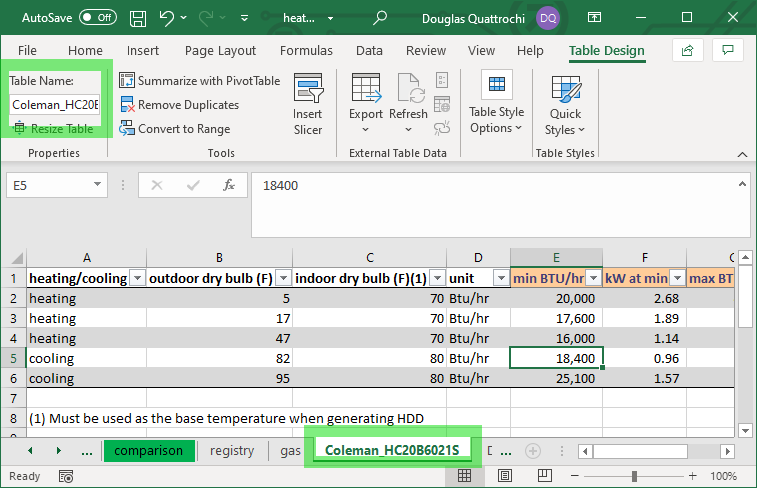
The most common name to miss is under "Table Design."
External Links
Energy Information Administration
- Historical Retail Price of Electricity over Time, MA
- Historical Retail Price of Natural Gas over Time, MA
- Predictions for Electricity and Natural Gas Prices through 2050
Energy Department
Resources
Become a member today.

